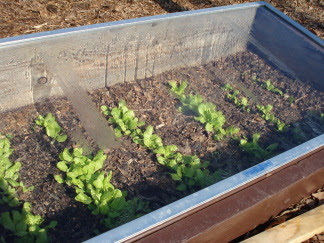Here is a picture of one of my cold frames with some lettuce growing happily (so far) in it. I have two cold frames---the second is taller than this one with sides made from 2 x 12's. In the second I have onions, kale and carrots. They could both be slightly improved with a coat of white paint on the inside but I have just NOT gotten to it---maybe this next summer.
Anyway, growing in these two frames this year was somewhat of an experiment since I started very very late with my seeding. The beginning of November if I remember correctly. For some reason I did not write it down like I am suppose to. With that late of a start I was not sure if the plants would actually sprout and grow well but so far so good. The kale and onions are taking a bit longer but the carrots and lettuce are growing quickly considering the amount of light we get. Somewhat helpful has been the weather which has been optimum for cold frame use: not to hot and not so cold I have to also blanket them. I have had to vent a few times---even removing the glass on a few days all together when we got some high 60's---but overall not much care has been needed. They're ideally located next to some of the animals that are fed twice a day so I can open and close them without forgetting---which is always something I have to consider since I forget very very easily.
Cold frames are something every gardener should have---at least one anyway---since they are great for that early season start of veggies in the spring: carrots, onions, kale, broccoli, cabbages lettuce, chard etc. and for late season starting of fall crops of the same or similar plants. In the late summer/early fall it is easy enough to use the cold frame with, not glass, but burlap across the top to provide shade. Either "hoop" some metal or plastic and drape it or lay some boards across the frame to hold it off the plants. Burlap is great for shielding plants and if you bring it in when your done with it you can use it for many seasons. I use wire mesh sold in rolls at the hardware store. Not the super small squares like you would use for bunny pens but the kind with opening about 2 inch by 2 inch. It is flexible--but still stiff and shape holding. It comes in 2 and 4 foot heights. I usually buy four foot but not always. Cut off the amount you need with a pair of pliers that have "wire nips" on them and then bend it in an arch. Because of the grid work it is easy to use string or wire twists to hold on the burlap or even cloths pins. When not in use stack them in an unobtrusive area until the fall when you can use them to drape frost fabric "cloche style" over them for late start plants. A cold frame allows for a warmer climate than this cloche type does---but both have their place in the garden.
There are many web sites and books that address cold frames, heat beds (warmed by electricity or manure), and various cloches. Check them out and if you don't do wood working---ask a neighbor or friend to help you. Or purchase simple tools that are not intimidating to use like a jigsaw and hammer and nails which will easily allow you to build one yourself. The investment of $40 dollars in tools is repaid by the use you get out of them again and again.
Oh yes: here's a cool summer cloche for bird protection or that bit of additional shade for transplants. Though I couldn't find an American supplier I think that transferring that idea to yard sale baskets with some slats taken out could work just fine.
My next picture is of our oink Pumpkin (the guinea hog). Who has, you will notice, a white stripe painted on her back---thanks to my DH while he was painting the front of her house.
The reason I put her picture up there was not so you could appreciate her beautiful new stripe but to show you how good of a tiller she is. Now, when it rains--she's at her best. When the soil is dry it takes her a while longer. Though there could be times when we may run out of tilling areas during a time of prolonged growth (as in the middle of the summer) it seems that with a small pig, such as she is, the winter will work out well to move her around to weed,till and get rid of pernicious weeds and stir in green manure crops and such. Unfortunately I didn't put any clover/vetch/rye etc in this fall because of the lack of rain but I have the seed and this next spring (if it rains like it is suppose to) I will. Pumpkin should be very helpful then as sometimes I find that, even when dried down, the rye and vetch (and even the clover sometimes) tangle in the blades of the tiller. I have shoulder problems so hand turning can be difficult for me at times---hence my reliance on a gas powered engine.
One thing we have noticed is that she doesn't like the potatoes or peanuts she digs up. Hmmmm...maybe with time.
The last picture is for the out of town person. Taken at same time as yesterday approximately. The picture is too small to see---but the log is floating by the Cypress tree.
Tuesday, November 27, 2007
Some fall/winter gardening
Posted by Monica: Dancingfarmer at 12:39 PM
Labels: animals, gardening, guinea hogs, heritage breeds, vegetable garden
Subscribe to:
Post Comments (Atom)



1 comment:
Nice pig.
Post a Comment